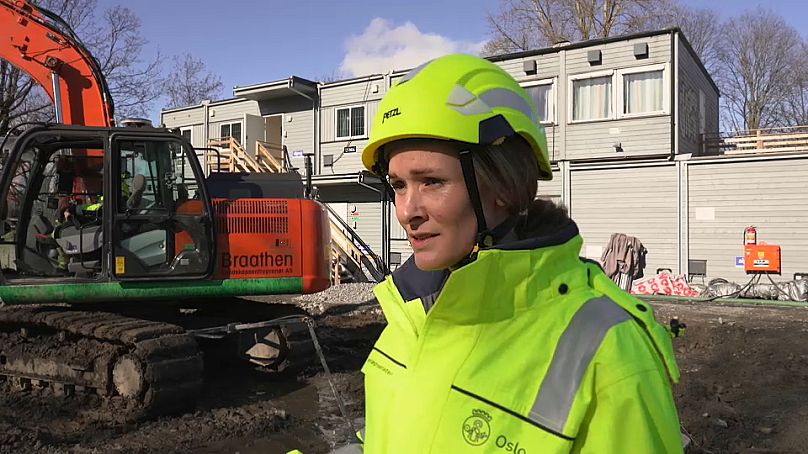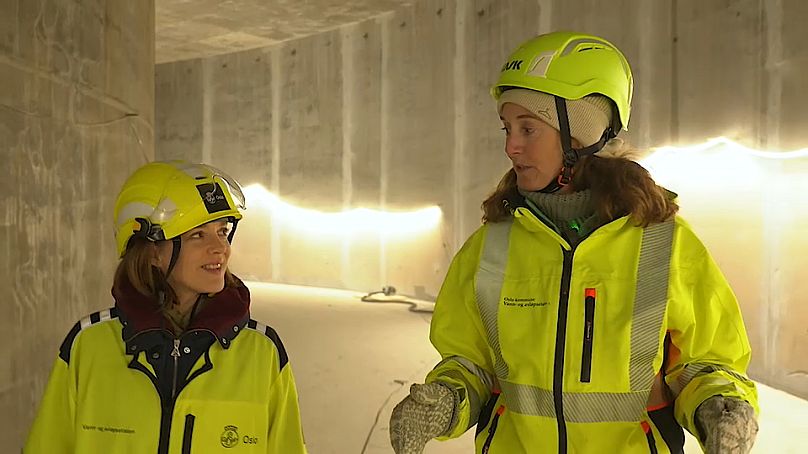In this latest episode of Business Planet, we discover how local authorities in Oslo are using public procurement to decarbonise the capital's construction sites.
In Oslo, building sites are undergoing a green transformation, as local authorities use public procurement to decarbonise Norway's construction industry.
The Klosterenga Park construction site is one such project funded by public spending. Here, teams are working to restore a long-buried stream, to offset potential floods and make the park more attractive. But the smelly fumes and noise pollution of diesel engines have been replaced by electric construction machines - making it a zero-greenhouse gas emission construction site.
“All the equipment used on this site is electrical. So that means zero emissions from this construction site at all,” explained Synnøve Bjerkestrand Halle, Project Manager at Oslo Municipality's Water and Sewerage Agency.
“We have two kindergartens next to the construction site [...] the kids are sleeping outside so it has to be quiet, but at this project we have been working during the sleeping hour because we have the electrical diggers and there have been zero complaints about noise from the two kindergartens, that’s 200 children who go there every day,” she added.
Worldwide, the construction industry is responsible for 10% of global greenhouse gas emissions. Oslo wants all municipal construction sites to be zero emissions by 2025.
"All our building and construction sites in Oslo, all roads, bike lanes, schools in 2022, 37% of the energy use of these building and construction sites were emissions-free and the rest was more or less fossil free," said Marit Hepsø, a specialist in sustainable buildings and construction sites for the Oslo municipality.
In Europe, around 250,000 public authorities spend around €2 trillion a year on services such as transport, waste management, health and education - 14% of Europe’s GDP and a lever to strengthen the single market.
The power of the public purse can be used to drive green goals or push social inclusion and other policy aims - like serving local organic food at school or boosting jobs and entrepreneurship - like the Dutch startup, The Great Bubble Barrier, which catches rubbish in the canals of Amsterdam.
Marit told Business Planet that public procurement has been a powerful tool to push Oslo's green ambitions forward.
"We have also been cooperating internationally to strengthen the use of this very important procurement muscle, we are a part of the Big Buyers project, which is an EU project cooperating with Barcelona, Copenhagen, Finland, because I think if you want to use the public procurement muscle you need to have more buyers on the same team going in the same direction to get more emission-free machines,” she added.
Elsewhere, high above Oslo, workers are pushing the boundaries of what is possible in terms of pollution-free construction.
One building project aims to supply local residents with fresh drinking water.
"We are inside one of the reservoirs, it’s one of two chambers and it’s going to be filled with 5,000 cubic metres of water," said Christin Kyseth Pettersen, the programme manager at Oslo municipality's Water and sewerage agency.
"We have all the zero-emission machines that [are] possible to use up here: excavators, handheld machines and we have electrical heating - before casting the cement we have to preheat the forms.
"The only thing is biogas because of the heavy-duty transport, like having all the concrete up here.
"We have to charge [the electrical machines] more often because it is very cold, especially during the winter months and there’s a lot of snow which makes it a little bit more hassle but it’s possible and as long as we can see that’s it possible to do it, we want to do it," Christin concludes.












